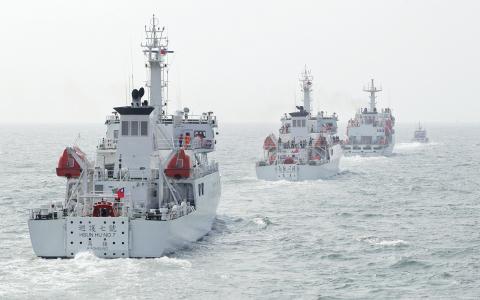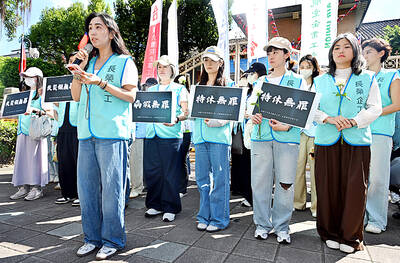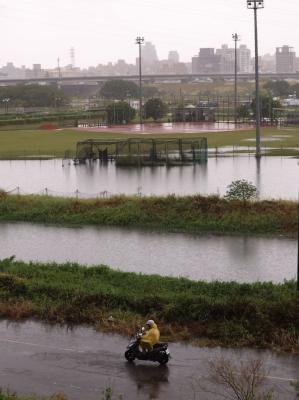The nation is building a US$100 million port next to an airstrip on the lone island it occupies in the disputed South China Sea, a move that is drawing hardly any flak from the most assertive player in the bitterly contested waters — China, military strategists said.
The reason is that Itu Aba (Taiping Island, 太平島) could one day be in China’s hands, should it ever take over Taiwan, they said.
While Itu Aba is small, no other disputed island has such sophisticated facilities. Its runway is the biggest of only two in the Spratly archipelago (Nansha Islands, 南沙群島) that straddles the South China Sea, and the island has its own fresh water source.

Photo: PICHI CHUANG, Reuters
“Taipei knows it is the only claimant that [China] will not bother, so it is free to upgrade its facilities on Taiping, without fear of criticism from China,” said Denny Roy, a senior fellow at the Hawaii-based East-West Center think tank. “China would protect Taiwan’s garrisons if necessary.”
The upgraded facilities on Itu Aba should be finished late next year or earlier, officials from the Ministry of National Defense and Ministry of Transportation and Communications said, replacing an existing wharf that can only handle small vessels.
The upgrade would give Taiwan a port able to accommodate 3,000 tonne naval frigates and coast guard cutters, while improvements are being made to the 1,200m runway for its Hercules C-130 transport planes, the officials said.
They said the new port was not just a demonstration of sovereignty, but also a way to support a trade-dependent economy, while helping the nation’s deep-sea fishermen and marine and mineral carry out research in the area.
About US$5 trillion in ship-borne goods pass through the South China Sea every year.
Taiwan and China share claims to virtually the entire South China Sea. Vietnam, the Philippines, Malaysia and Brunei also claim parts of the potentially oil-rich sea.
While Taiwan-China ties have warmed since President Ma Ying-jeou (馬英九) came to power in 2008, there has been no political reconciliation or a lessening of military distrust.
However, if conflict ever broke out in the Spratlys, analysts and military experts believe China would seek to protect Itu Aba as its own, strongly aware of its strategic value.
The Spratlys are one of the main flashpoints in the South China Sea, where military fortifications belonging to all claimants, except Brunei, are dotted across some of the world’s busiest shipping lanes.
China occupies eight shoals and reefs, but its strategists have long bristled at Vietnam’s two dozen holdings. Manila occupies eight reefs and islands, and Malaysia seven.
Incidents at sea in recent years, such as ships getting rammed or attempted blockades, have usually involved China against the Philippines or Vietnam.
Zhang Zhexin (張哲馨), a research fellow on Taiwan issues at the Shanghai Institute for International Studies, said Beijing would not have a problem with the nation developing Itu Aba.
“Taiwan itself is Chinese territory anyway,” he said.
“How can we have a territorial dispute within our own country? Of course Taiwan is part of China, so that includes all parts of China, including Taiping Island,” he said.
The island, administered by the Coast Guard Administration, is about 1,600km southwest of Taiwan, out of range of its US-made F-16 warplanes, lying between the Philippines, Vietnam and Malaysia.
Unlike Beijing, Taipei is low-key about asserting its claims in the South China Sea and does not deploy naval or civilian fleets to the outer limits of the so-called nine-dash line that Beijing displays on its official maps and which reaches deep into maritime Southeast Asia, strategists say.
The nation has not trumpeted its upgrade to Itu Aba.
“We would never invade islands occupied by other nations, but we will actively defend our claims,” said a spokesman for Chinese Nationalist Party (KMT) Legislator Lin Yu-fang (林郁方), a key backer of the port project.
The facility would provide services to any Taiwanese ships in the region, said Chen I-piao, acting chief engineer at the Taiwan Area National Expressway Administration Bureau, the unit responsible for building the wharf.
“Previously our vessels in the area had to liaise with other ships if they needed assistance. After the port is finished they’ll be able to directly call at port,” Chen said.
Scores of Vietnamese and Chinese ships continue to square off around the rig, placed between the Paracel Islands (Xisha Islands, 西沙群島) occupied by China and the Vietnamese coast guard.
While Vietnam and the Philippines have protested plans by Taiwan to upgrade the wharf, the construction is generating much less heat than Beijing’s muscle-flexing in the South China Sea.
Days after China deployed the oil rig to the Paracel chain, the Philippines accused Beijing of reclaiming land on a disputed reef in the Spratlys to build what would be its first airstrip in the South China Sea.
China has rejected a Philippine protest over the air strip construction on Johnson South Reef (Chigua Reef, 赤瓜礁), saying it has the right to develop its territory.
Experts say any airstrip there would unlikely be a strategic game-changer because of the difficulty in building a workable runway on an atoll, unlike an island like Itu Aba.
And as Itu Aba is the largest island in the Spratlys and the only one with natural water supplies, legal experts say this could help any future formal claim to a 200 nautical mile (370km) exclusive economic zone and any fish and oil within it.
The nation has not cooperated with China on the South China Sea, despite the historical ties to each other’s claims, given the political mistrust between them, but also because of the nation’s need to maintain good relations with the US, said a vocal critic of Beijing’s policies in the disputed waters, experts say.
For the most part, Taiwan has kept its head down, not wanting to upset China or claimants in Southeast Asia given its economic links to all, strategists say.
At various times, the nation has pushed to be involved in regional mechanisms to easing tensions, but resistance from China means it plays no part in any efforts through ASEAN, they said.
“I think the major concern is US-Taiwan relations. The US government asked Taiwan not to move close to China on the South China Sea,” said Song Yann-huei (宋燕輝), a South China Sea expert at Academia Sinica.

The Taoyuan Flight Attendants’ Union yesterday vowed to protest at the EVA Air Marathon on Sunday next week should EVA Airway Corp’s management continue to ignore the union’s petition to change rules on employees’ leave of absence system, after a flight attendant reportedly died after working on a long-haul flight while ill. The case has generated public discussion over whether taking personal or sick leave should affect a worker’s performance review. Several union members yesterday protested at the Legislative Yuan, holding white flowers and placards, while shouting: “Life is priceless; requesting leave is not a crime.” “The union is scheduled to meet with

‘UNITED FRONT’ RHETORIC: China’s TAO also plans to hold weekly, instead of biweekly, news conferences because it wants to control the cross-strait discourse, an expert said China’s plan to expand its single-entry visa-on-arrival service to Taiwanese would be of limited interest to Taiwanese and is a feeble attempt by Chinese administrators to demonstrate that they are doing something, the Mainland Affairs Council said yesterday. China’s Taiwan Affairs Office (TAO) spokesman Chen Binhua (陳斌華) said the program aims to facilitate travel to China for Taiwanese compatriots, regardless of whether they are arriving via direct flights or are entering mainland China through Hong Kong, Macau or other countries, and they would be able to apply for a single-entry visa-on-arrival at all eligible entry points in China. The policy aims

Taipei, New Taipei City, Keelung and Taoyuan would issue a decision at 8pm on whether to cancel work and school tomorrow due to forecasted heavy rain, Keelung Mayor Hsieh Kuo-liang (謝國樑) said today. Hsieh told reporters that absent some pressing reason, the four northern cities would announce the decision jointly at 8pm. Keelung is expected to receive between 300mm and 490mm of rain in the period from 2pm today through 2pm tomorrow, Central Weather Administration data showed. Keelung City Government regulations stipulate that school and work can be canceled if rain totals in mountainous or low-elevation areas are forecast to exceed 350mm in

EVA Airways president Sun Chia-ming (孫嘉明) and other senior executives yesterday bowed in apology over the death of a flight attendant, saying the company has begun improving its health-reporting, review and work coordination mechanisms. “We promise to handle this matter with the utmost responsibility to ensure safer and healthier working conditions for all EVA Air employees,” Sun said. The flight attendant, a woman surnamed Sun (孫), died on Friday last week of undisclosed causes shortly after returning from a work assignment in Milan, Italy, the airline said. Chinese-language media reported that the woman fell ill working on a Taipei-to-Milan flight on Sept. 22